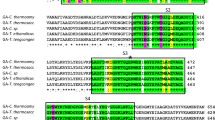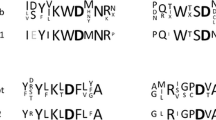Abstract
A gene encoding an intracellular glucoamylase was identified in the genome of the extreme thermoacidophilic Archaeon Thermoplasma acidophilum. The gene taGA, consisting of 1,911 bp, was cloned and successfully expressed in Escherichia coli. The recombinant protein was purified 22-fold to homogeneity using heat treatment, anion-exchange chromatography, and gel filtration. Detailed analysis shows that the glucoamylase, with a molecular weight of 66 kDa per subunit, is a homodimer in its active state. Amylolytic activity was measured over a wide range of temperature (40–90°C) and pH (pH 3.5–7) and was maximal at 75°C and at acidic condition (pH 5). The recombinant archaeal glucoamylase uses a variety of polysaccharides as substrate, including glycogen and amylose. Maximal activity was measured towards amylopectin with a specific activity of 4.2 U/mg and increased almost threefold in the presence of manganese. Calcium ions have a pronounced effect on enzyme stability; in the presence of 5 mM CaCl2, the half-life increased from 15 min to 2 h at 80°C.






Similar content being viewed by others
References
Altschul SF, Lipman DJ (1990) Protein database searches for multiple alignments. Proc Natl Acad Sci U S A 87:5509–5513
Altschul SF, Madden TL, Schaffer AA, Zhang J, Zhang Z, Miller W, Lipman DJ (1997) Gapped BLAST and PSI-BLAST: a new generation of protein database search programs. Nucleic Acids Res 25:3389–3402
Angelov A, Liebl W (2006) Insights into extreme thermoacidophily based on genome analysis of Picrophilus torridus and other thermoacidophilic archaea. J Biotechnol 126:3–10
Bendtsen JD, Nielsen H, von Heijne G, Brunak S (2004) Improved prediction of signal peptides: SignalP 3.0. J Mol Biol 340:783–795
Bernfeld P (1955) Amylases alpha and beta. Methods Enzymol 1:149–158
Berriman M, Rutherford K (2003) Viewing and annotating sequence data with Artemis. Brief Bioinform 4:124–132
Bertoldo C, Antranikian G (2002) Starch-hydrolyzing enzymes from thermophilic archaea and bacteria. Curr Opin Chem Biol 6:151–160
Britton HTS, Robinson RA (1931) Universal buffer solutions and the dissociation constant of Veronal. J Chem Soc 1931:1456–1462
Chung YC, Kobayashi T, Kanai H, Akiba T, Kudo T (1995) Purification and properties of extracellular amylase from the hyperthermophilic archaeon Thermococcus profundus DT5432. Appl Environ Microbiol 61:1502–1506
Coutinho PM, Henrissat B (1999) Carbohydrate-active enzymes: an integrated database approach. In: Gilbert HJ, Davies G, Henrissat B, Svensson B (eds) Recent advances in carbohydrate bioengineering. The Royal Society of Chemistry, Cambridge, pp 3–12
Coutinho PM, Reilly PJ (1994a) Structural similarities in glucoamylase by hydrophobic cluster analysis. Protein Eng 7:749–760
Coutinho PM, Reilly PJ (1994b) Structure–function relationships in the catalytic and starch binding domains of glucoamylase. Protein Eng 7:393–400
Deppenmeier U, Johann A, Hartsch T, Merkl R, Schmitz RA, Martinez-Arias R, Henne A, Wiezer A, Baumer S, Jacobi C et al (2002) The genome of Methanosarcina mazei: evidence for lateral gene transfer between bacteria and archaea. J Mol Microbiol Biotechnol 4:453–461
Dopson M, Baker-Austin C, Hind A, Bowman JP, Bond PL (2004) Characterization of Ferroplasma isolates and Ferroplasma acidarmanus sp. nov., extreme acidophiles from acid mine drainage and industrial bioleaching environments. Appl Environ Microbiol 70:2079–2088
Futterer O, Angelov A, Liesegang H, Gottschalk G, Schleper C, Schepers B, Dock C, Antranikian G, Liebl W (2004) Genome sequence of Picrophilus torridus and its implications for life around pH 0. Proc Natl Acad Sci U S A 101:9091–9096
GOLD (2006) The Genomes On Line Database. Available at www.genomesonline.org. Accessed on October 11th 2006
Hendrickson EL, Kaul R, Zhou Y, Bovee D, Chapman P, Chung J, Conway de Macario E, Dodsworth JA, Gillett W, Graham DE et al (2004) Complete genome sequence of the genetically tractable hydrogenotrophic methanogen Methanococcus maripaludis. J Bacteriol 186:6956–6969
Henrissat B (1991) A classification of glycosyl hydrolases based on amino acid sequence similarities. Biochem J 280(Pt 2):309–316
Henrissat B, Bairoch A (1993) New families in the classification of glycosyl hydrolases based on amino acid sequence similarities. Biochem J 293(Pt 3):781–788
Itoh T, Sakata Y, Akada R, Nimi O, Yamashita I (1989) Construction and characterization of mutant glucoamylases from the yeast Saccharomycopsis fibuligera. Agric Biol Chem 53:3159–3167
Kawashima T, Amano N, Koike H, Makino S, Higuchi S, Kawashima-Ohya Y, Watanabe K, Yamazaki M, Kanehori K, Kawamoto T et al (2000) Archaeal adaptation to higher temperatures revealed by genomic sequence of Thermoplasma volcanium. Proc Natl Acad Sci U S A 97:14257–14262
Kim MS, Park JT, Kim YW, Lee HS, Nyawira R, Shin HS, Park CS, Yoo SH, Kim YR, Moon TW et al (2004) Properties of a novel thermostable glucoamylase from the hyperthermophilic archaeon Sulfolobus solfataricus in relation to starch processing. Appl Environ Microbiol 70:3933–3940
Laemmli UK (1970) Cleavage of structural proteins during the assembly of the head of bacteriophage T4. Nature 227:680–685
Nigam P, Singh D (1995) Enzyme and microbial systems involved in starch processing. Enzyme Microb Technol 17:770–778
Norouzian D, Akbarzadeh A, Scharer JM, Moo Young M (2006) Fungal glucoamylases. Biotechnol Adv 24:80–85
Ruepp A, Graml W, Santos-Martinez ML, Koretke KK, Volker C, Mewes HW, Frishman D, Stocker S, Lupas AN, Baumeister W (2000) The genome sequence of the thermoacidophilic scavenger Thermoplasma acidophilum. Nature 407:508–513
Sambrook J, Fritsch EF, Maniatis T (1989) Molecular cloning: a laboratory manual, 2nd edn. Cold Spring Harbor Laboratory Press, Cold Spring Harbor, NY
Sanger F, Nicklen S, Coulson AR (1977) DNA sequencing with chain-terminating inhibitors. Proc Natl Acad Sci U S A 74:5463–5467
Sauer J, Sigurskjold BW, Christensen U, Frandsen TP, Mirgorodskaya E, Harrison M, Roepstorff P, Svensson B (2000) Glucoamylase: structure/function relationships, and protein engineering. Biochim Biophys Acta 1543:275–293
Schepers B, Thiemann V, Antranikian G (2006) Characterization of a novel glucoamylase from the thermoacidophilic archaeon Picrophilus torridus heterologously expressed in E. coli. Eng Life Sci 6:311–317
Searcy DG (1976) Thermoplasma acidophilum: intracellular pH and potassium concentration. Biochim Biophys Acta 451:278–286
Serour E, Antranikian G (2002) Novel thermoactive glucoamylases from the thermoacidophilic archaea Thermoplasma acidophilum, Picrophilus torridus and Picrophilus oshimae. Antonie Van Leeuwenhoek 81:73–83
Sierks MR, Svensson B (1993) Functional roles of the invariant aspartic acid 55, tyrosine 306, and aspartic acid 309 in glucoamylase from Aspergillus awamori studied by mutagenesis. Biochemistry 32:113–1117
Thompson JD, Higgins DG, Gibson TJ (1994) CLUSTAL W: improving the sensitivity of progressive multiple sequence alignment through sequence weighting, position-specific gap penalties and weight matrix choice. Nucleic Acids Res 22:4673–4680
Thompson JD, Gibson TJ, Plewniak F, Jeanmougin F, Higgins DG (1997) The CLUSTAL_X windows interface: flexible strategies for multiple sequence alignment aided by quality analysis tools. Nucleic Acids Res 25:4876–4882
Uotsu-Tomita R, Tonozuka T, Sakai H, Sakano Y (2001) Novel glucoamylase-type enzymes from Thermoactinomyces vulgaris and Methanococcus jannaschii whose genes are found in the flanking region of the alpha-amylase genes. Appl Microbiol Biotechnol 56:465–473
Acknowledgments
This work was supported by grant 04-008 202131 from the German Federal Ministry of Education and Research. We would like to thank Moritz Katzer for his support.
Author information
Authors and Affiliations
Corresponding author
Rights and permissions
About this article
Cite this article
Dock, C., Hess, M. & Antranikian, G. A thermoactive glucoamylase with biotechnological relevance from the thermoacidophilic Euryarchaeon Thermoplasma acidophilum . Appl Microbiol Biotechnol 78, 105–114 (2008). https://doi.org/10.1007/s00253-007-1293-1
Received:
Revised:
Accepted:
Published:
Issue Date:
DOI: https://doi.org/10.1007/s00253-007-1293-1




